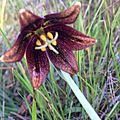Mission bells facts for kids
Quick facts for kids Mission bells |
|
|---|---|
 |
|
| Scientific classification | |
| Kingdom: | |
| (unranked): | |
| (unranked): | |
| Order: | |
| Family: | |
| Genus: |
Fritillaria
|
| Species: |
F. biflora
|
| Binomial name | |
| Fritillaria biflora |
|
| Synonyms | |
|
|
The Chocolate Lily (also known as Mission Bells) is a beautiful plant. Its scientific name is Fritillaria biflora. This plant is a type of fritillary. It grows naturally in western California and northern Baja California in Mexico.
You can often find it in areas called chaparral and woodlands. It likes to grow in special serpentine soil and on grassy hillsides. The Chocolate Lily is called this because its flowers often look like the color of chocolate. However, their colors can also be dark brown, greenish-purple, or yellowish-green. These flowers usually bloom in March and April.
This plant is a perennial herb. This means it lives for more than two years and has soft stems, not woody ones. It can grow up to 60 centimeters (about 2 feet) tall.
Similar Plants
It's easy to get the Chocolate Lily (Fritillaria biflora) mixed up with other plants. For example, there's another plant called Arthropodium strictum that is also known as "chocolate lily." But for that plant, it's the smell that reminds people of chocolate, not the color.
Also, the Kamchatka fritillary (F. camschatcensis) is sometimes called "chocolate lily" in Alaska. So, it's good to know the scientific names to be sure which plant you are talking about!
Plant Varieties
Just like there are different types of apples, there can be different types, or varieties, of plants within the same species. For the Chocolate Lily, scientists recognize two main varieties:
- Fritillaria biflora var. biflora: This is the most common type. Its leaves are wide and shaped like a spear (lanceolate). You can find this variety in most places where the Chocolate Lily grows.
- Fritillaria biflora var. ineziana: This variety is quite rare. Its leaves are narrow and spear-shaped. It was first described in 1922. Sadly, this plant is an endangered type. It is only known to grow in one specific spot in San Mateo County, California.
Images for kids




